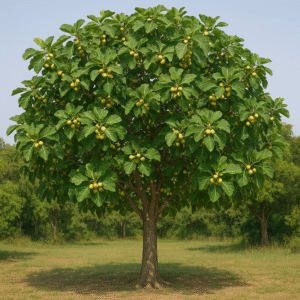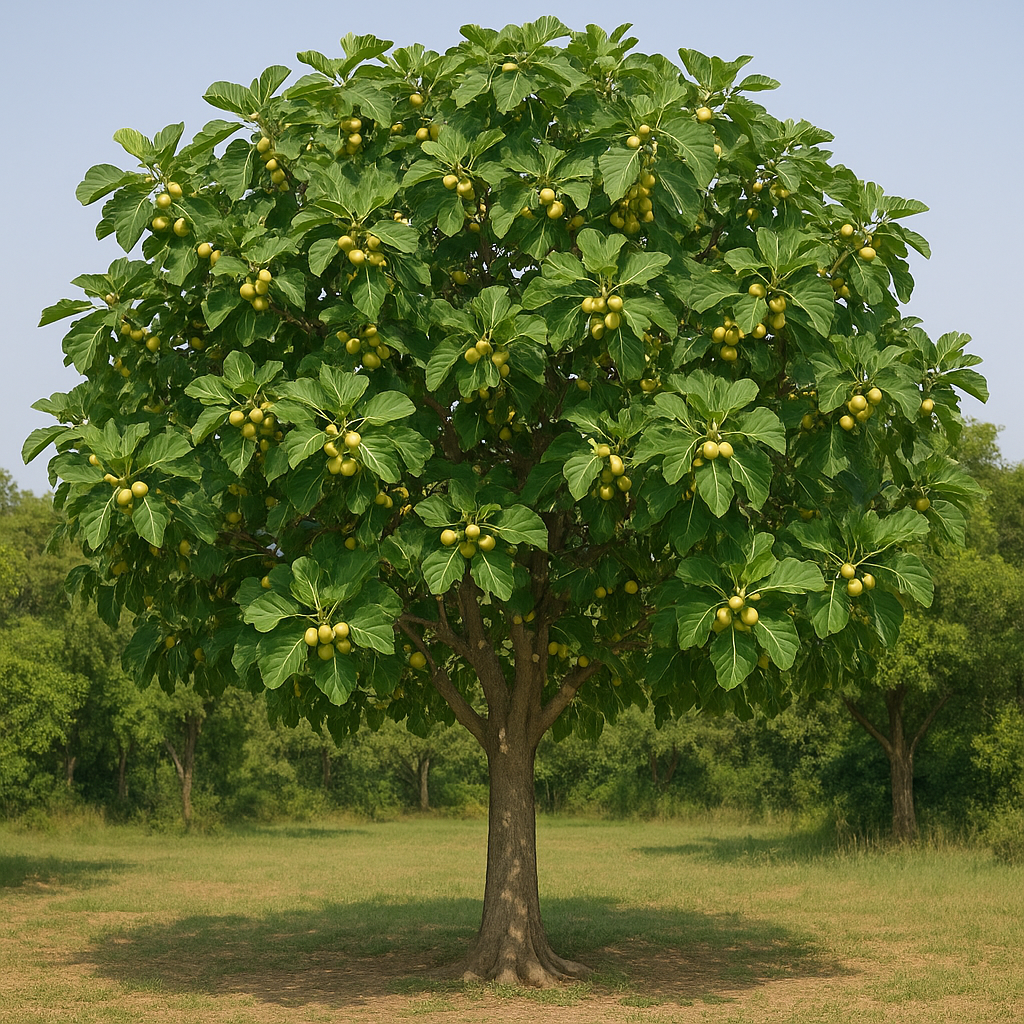The white fig tree, scientifically known as Ficus guaranitica, is a native species of the tropical and subtropical regions of South America. Commonly found in Brazil, Paraguay, and Argentina, this tree has gained attention not only for its ornamental appeal but also for its ecological and cultural importance. Its broad leaves and pale fruits stand out in any landscape, and its adaptability makes it suitable for both reforestation and home cultivation.
In this article, you’ll discover everything you need to know about the white fig tree: its botanical features, ecological role, practical uses, and how to grow it successfully—even in small spaces.
Botanical Characteristics
The white fig tree can grow between 5 to 15 meters tall in its natural environment, although its growth is more compact when cultivated in pots or urban areas. The name “white fig” refers to the light color of its ripe fruits, which contrast beautifully with the dark green foliage and light brown trunk.
The leaves are alternate, large, and leathery, with smooth edges and a glossy finish. The tree produces small, fig-like fruits known as syconia, which are edible and attract birds, bees, and other pollinators.
Being an evergreen species, the white fig tree retains its leaves year-round, making it an ideal choice for shade and landscaping. Its dense canopy offers a natural refuge for urban wildlife and enhances biodiversity wherever it is planted.
Natural Habitat
In the wild, the white fig tree thrives along forest edges, riverbanks, and in Atlantic Forest regions. It’s commonly found across southern and southeastern Brazil and can adapt to environments like the Cerrado and even parts of the Caatinga biome, showing impressive ecological flexibility.
Its ability to grow in various soil types makes it a valuable species for land restoration and ecological recovery in degraded areas.
Ecological Importance
The white fig tree plays a vital role in the ecosystem. Its fruits are a key food source for many bird species, bats, and small mammals. In return, these animals help disperse the tree’s seeds, supporting natural forest regeneration.
The root system of the tree is also beneficial, helping to stabilize soil and prevent erosion, especially in riparian zones and steep landscapes.
One of the most fascinating ecological relationships involving the white fig tree is its interaction with specific fig wasps, which complete their life cycle within the tree’s syconia. This mutualistic relationship is a remarkable example of tropical biodiversity at work.
How to Grow a White Fig Tree
Despite being a hardy native species, the white fig tree thrives best under certain conditions:
1. Climate and Light: Prefers tropical to subtropical climates with plenty of sunlight. Can be grown in full sun or partial shade.
2. Soil: Adapts to many soil types but grows best in fertile, well-drained soils rich in organic matter.
3. Watering: During the first year, water regularly to keep the soil moist. Once established, the tree becomes relatively drought-tolerant.
4. Pruning: Light pruning helps shape the canopy and control the tree’s size in confined spaces.
5. Propagation: Can be propagated via seeds or cuttings. Seeds germinate easily in moist, protected soil.
Urban Cultivation and Practical Use
Although it is a medium-sized tree, the white fig can be successfully grown in large pots or raised garden beds. This makes it suitable for patios, urban gardens, and even vertical gardening systems.
Growing a white fig tree in small spaces not only adds aesthetic value but also contributes to environmental sustainability, especially when combined with multi-layered planters or modular containers.
For those living in apartments or homes with limited outdoor areas, a vertical planter system can be a smart, space-saving solution.
Fun Facts
-
The latex from the white fig tree is used in traditional medicine to treat inflammation and skin issues—though it should be handled with caution.
-
Some indigenous cultures regard the fig tree as sacred, symbolizing protection, fertility, and connection with nature.
-
In humid climates, the tree may develop aerial roots, creating a dramatic and exotic appearance.
A Green Step Toward Sustainability
Planting a native tree like the white fig is more than an aesthetic choice—it’s an environmental statement. It supports local wildlife, improves air quality, and connects us to the native richness of our ecosystem.
Even if you don’t have a large yard, you can bring the beauty and function of the white fig into your home using creative planting methods. That’s why this final tip might be just what you need:

Give life to your home garden with smart and elegant design!
Try the VIVOSUN 5-Tier Vertical Stackable Planter for strawberries, flowers, herbs, and vegetables – Ivory color.
A perfect fit for growing your white fig tree in small spaces with style and practicality.

